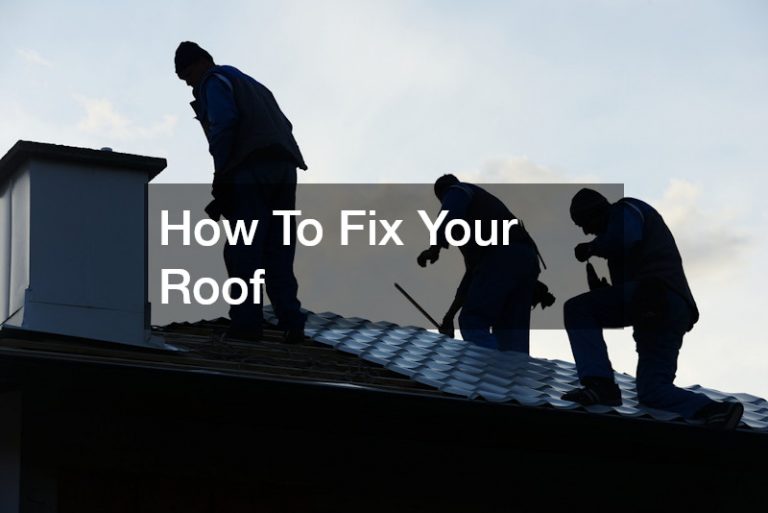Every homeowner eventually faces a moment where the roof starts showing signs of trouble. Maybe you noticed a small leak, missing shingles, or storm damage that appeared overnight. Knowing how to approach roof repair is essential for protecting your home, preventing expensive long-term damage, and maintaining structural integrity. Even if you do not plan to climb on the roof yourself, understanding the fundamentals of roof repair helps you communicate better with contractors and make informed decisions.
This guide breaks down the most common problems, the tools you need, step-by-step fixes, and when to call a professional.
Recognizing When You Need Roof Repair
Before tackling any project, you must know the warning signs that indicate roof repair is necessary. Some of the most common include:
Water stains on ceilings or walls
Dripping during heavy rain
Curled, cracked, or missing shingles
Shingle granules washing into gutters
Moss, mold, or algae growth
Soft or spongy areas when walking on the roof
Damaged flashing around vents, chimneys, or skylights
When these symptoms appear, acting quickly prevents further damage. Roof repair is most effective when problems are caught early.
Start With a Safe Inspection
Safety comes first. Before beginning any roof repair, inspect the roof safely and correctly:
Use a sturdy ladder and ensure it is on level ground
Wear shoes with strong traction
Never walk on wet or icy roofs
Avoid steep pitches unless trained
Have someone nearby for assistance
Inspect both the exterior and interior of the home. Look for wet insulation, daylight peeking through the attic, or sagging roof decking. These signs reveal the extent of the roof repair needed.
Common Roof Repair Situations and How To Fix Them
Below are the most frequent roof issues homeowners face and how to address them effectively.
1. Fixing Missing or Damaged Shingles
One of the simplest roof repair tasks is replacing missing or broken shingles.
Steps:
Carefully lift surrounding shingles using a pry bar.
Remove nails holding the damaged shingle.
Slide in the new shingle.
Nail it securely into place.
Seal edges with roofing cement to prevent leaks.
Shingles protect the structure beneath them, so repairing missing ones is essential.
2. Sealing Small Roof Leaks
Small leaks often form around nails, seams, or flashing. To patch them:
Clean the area thoroughly.
Apply roofing cement under loose shingle edges.
Press the shingle back down and seal the surface.
For cracks or holes, use a patch of asphalt roofing fabric with cement.
This quick roof repair solution works well temporarily but may require a more permanent fix later.
3. Repairing Flashing Around Vents and Chimneys
Flashing is one of the top causes of leaks. When flashing separates or rusts, water slips underneath.
Steps for flashing roof repair:
Remove surrounding shingles.
Pry away damaged flashing.
Install new flashing with roofing nails.
Overlay shingles and seal joints with roof cement.
Proper flashing work prevents long-term water intrusion.
4. Fixing Roof Vent Problems
Vent boots around plumbing stacks can crack over time. If water enters around a vent:
Remove the damaged vent boot.
Slide a new boot over the vent pipe.
Nail it into place under surrounding shingles.
Seal edges carefully.
This roof repair task eliminates one of the most common leak sources.
5. Dealing With Gutter and Drainage Issues
Sometimes the issue is not the roof itself. Clogged gutters cause overflow and force water beneath shingles.
Solutions:
Clean gutters thoroughly
Add gutter guards if needed
Ensure downspouts direct water away from the home
This simple fix prevents structural damage and reduces the need for future roof repair.
Tools and Materials You Will Need
To perform most roof repair tasks, have the following:
Roofing hammer or nail gun
Roofing cement
Pry bar
Replacement shingles
Utility knife
Ladder
Caulk gun
Flashing panels
Safety harness if working on slopes
Having proper tools ensures clean, effective repairs.
When You Should NOT Attempt Roof Repair Yourself
While many small issues are manageable, some roof repair situations require a professional:
Structural sagging
Widespread shingle loss
Persistent, hidden leaks
Storm or hail damage
Rotting deck boards
Chimney or skylight failure
Steep or dangerous roof pitches
Attempting complex roof repair without training risks injury and improper fixes that lead to bigger problems.
If your roof is near the end of its lifespan (15 to 25 years depending on material), repeated repairs may only postpone the inevitable. In such cases, replacement may be more cost effective than continuous roof repair.
Preventative Maintenance to Reduce Future Repairs
A well maintained roof lasts longer and requires fewer repairs. Keep your roof in good shape by:
Clearing debris yearly
Checking gutters every season
Trimming overhanging branches
Inspecting shingles after storms
Checking attic ventilation and insulation
Scheduling annual roof inspections
Proactive care prevents unnecessary roof repair and keeps your home protected year round.
Final Thoughts
Understanding how to fix your roof empowers you to handle small issues confidently, recognize larger problems early, and avoid expensive damage. Whether you are replacing a few shingles, sealing a minor leak, or repairing flashing, the right approach to roof repair keeps your home dry, secure, and structurally sound. While some tasks are DIY friendly, do not hesitate to bring in professionals for complex or dangerous repairs.

